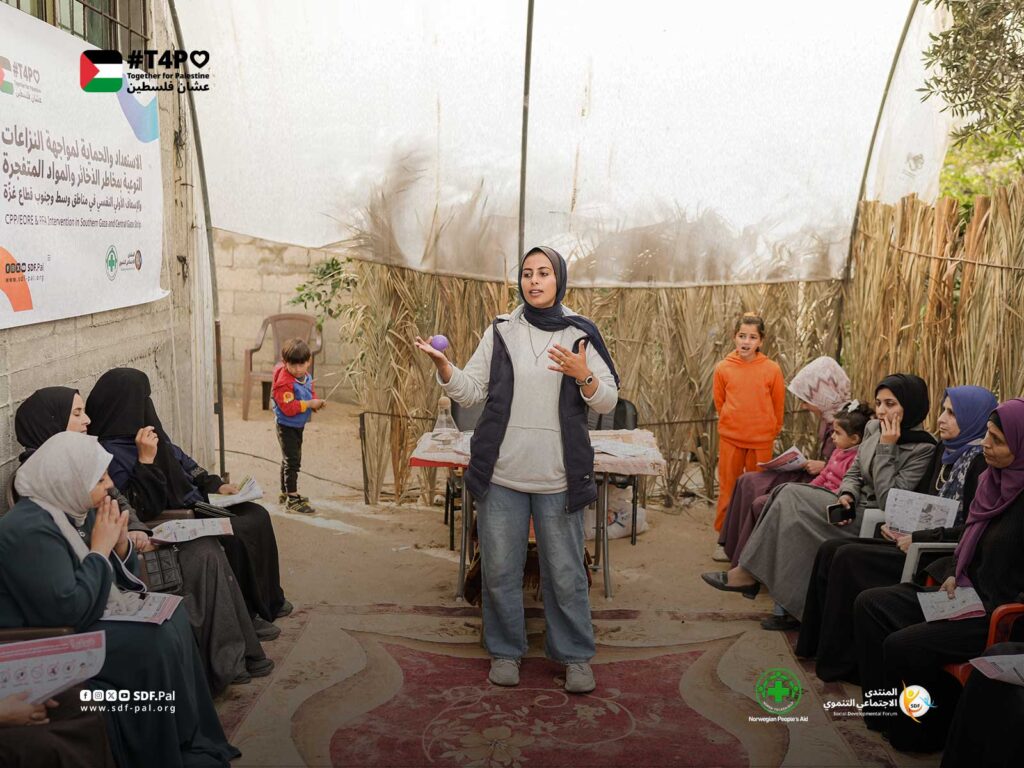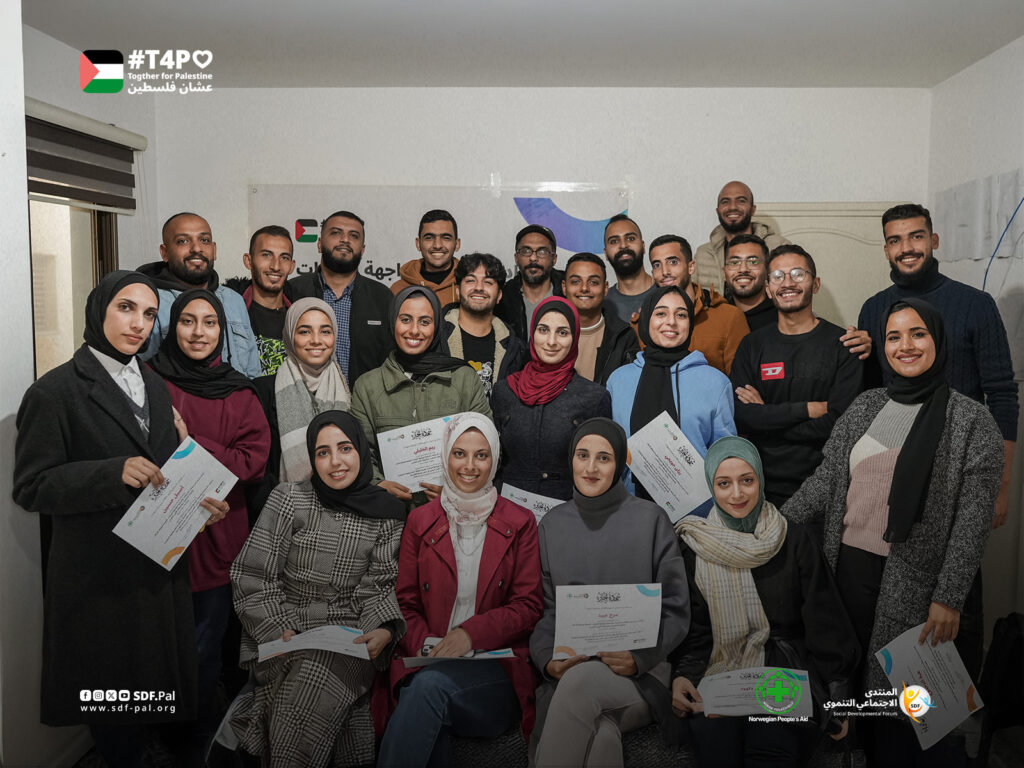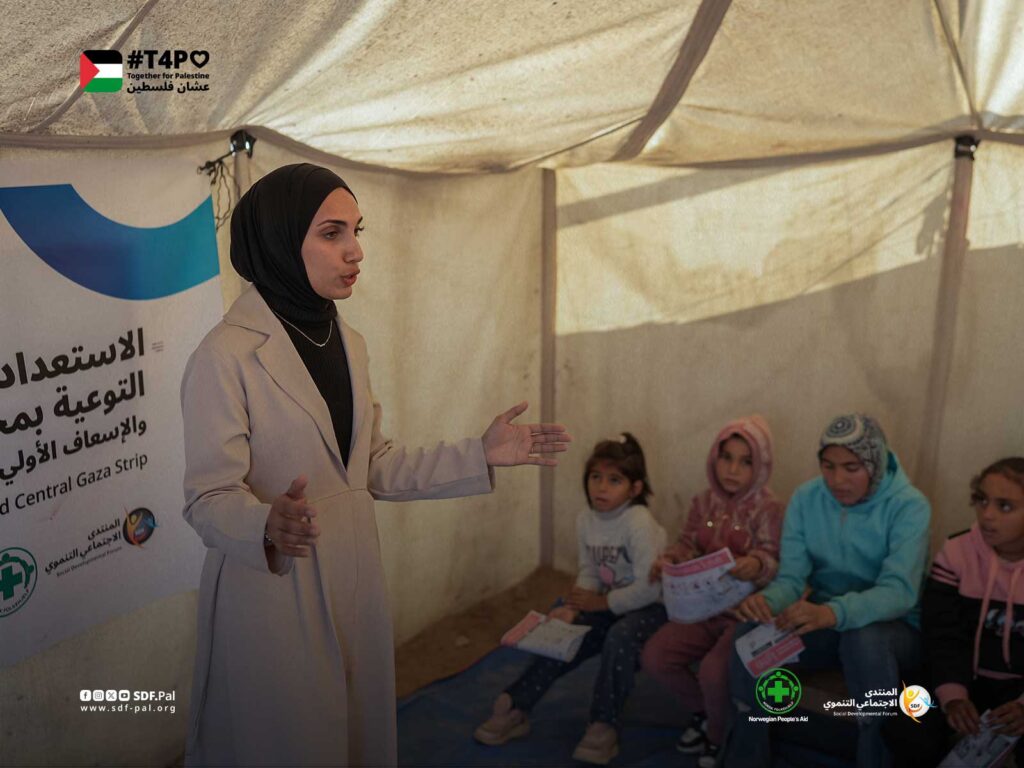Awareness-raising sessions on conflict preparedness and protection: a significant effort targeting thousands of displaced persons

Dozens of awareness-raising sessions on conflict preparedness and protection, explosive ordnance, and psychological first aid have been launched to educate the displaced community across the Gaza Strip. These workshops were conducted in the middle and southern governorates, targeting thousands of people sheltering in makeshift camps.
After completing an intensive 42-hour training in preparedness and protection, 20 young leaders led 144 comprehensive sessions and disseminated informative brochures throughout the camps. This model is the first of its kind in the Gaza Strip.
These sessions are part of the project “Preparedness and protection for conflict response, awareness of munitions and explosive ordnance, and psychological first aid in the middle and southern areas of Gaza,” implemented by the Social Developmental Forum in partnership with Norwegian People’s Aid (NPA).

Thousands of Beneficiaries
The youth-led awareness sessions targeted approximately 2,077 displaced individuals in the middle and south Gaza, offering them hands-on knowledge and skills to cope during attacks, forcible displacement, and other war-related emergencies. Young trainers delivered these sessions in displacement camps, aiming to enhance prospects of physical and mental survival after more than 400 days of interrupted schooling and relentless hostilities.
Participants themselves participated in a series of “Training of Trainers” workshops on designing, managing, and presenting life-saving advice. They learned techniques that enhance physical safety and manage stress and anxiety.

A Meaningful Impact
In the face of ongoing bombardment, invasions, and the daily struggle for survival, these workshops provided lifesaving information. Aya Abu Diya, a participant at one of those sessions, shared:
The workshop enhanced our survival practices. We learned what to do during forcible displacement, what to pack in an emergency bag, and other helpful emergency tips.
Om al-Abd Shakshak, one of the supervisors at the camp where a workshop was held, remarked: “I have been displaced many times, sheltering in makeshift tents. We gained valuable information from the session, tips that we didn’t consider before. It is a guiding effort that ultimately fosters survival and mitigates physical and logistical risks.”

While the young participant, Sara Fawrah, said: “I attended the session and learned how to remain safe from explosive ordnance. Risk education is important so that we can enhance our safety measures and avoid possible injuries.”
The 19-year-old Ayat Radwan, who engaged in one of the youth-oriented workshops, shared: “The workshop was wonderful. It introduced me to things I didn’t know before—like the protective stance, the fetal and chair positions. These will make a significant shift in the way I will behave during future emergencies. It is a helpful guide for everyone.”
Suhair Muʿin Tutah is a displaced young girl from Al Zaytoun neighborhood to Deir al-Balah, added: “Such an excellent effort to enhance protection. I learned about the risks of munitions and explosive materials and how to protect myself and people around me, things I didn’t know before.”
A different experience!
Marah ʿUbaid, one of the preparedness and protection trainers, reflected on her role: “Leading these workshops wasn’t a mere task. It’s driven by a sense of social and national responsibility. I heard participants’ eye-opening reflections, which motivates me to engage more and more in this awareness effort to contribute to equipping people with knowledge and tactics to protect themselves and their loved ones, both physically and psychologically.”

The young trainer Isrāʾa Abū Shuʿayrah, also noted:
Participants already had general knowledge of psychological issues from previous courses, but I was able to add an important layer, particularly on psychological first aid and how it differs from longer-term psychosocial support. At the end of each session, attendees praised the information they’d received and said it was both vital and highly beneficial.”
These workshops targeted a diverse audience of the displaced community, including the elderly, women, girls, and youth, who showed keen interest in what the young trainers offered, often comparing the guidance tactics to the harsh realities they face under siege and bombardment.

